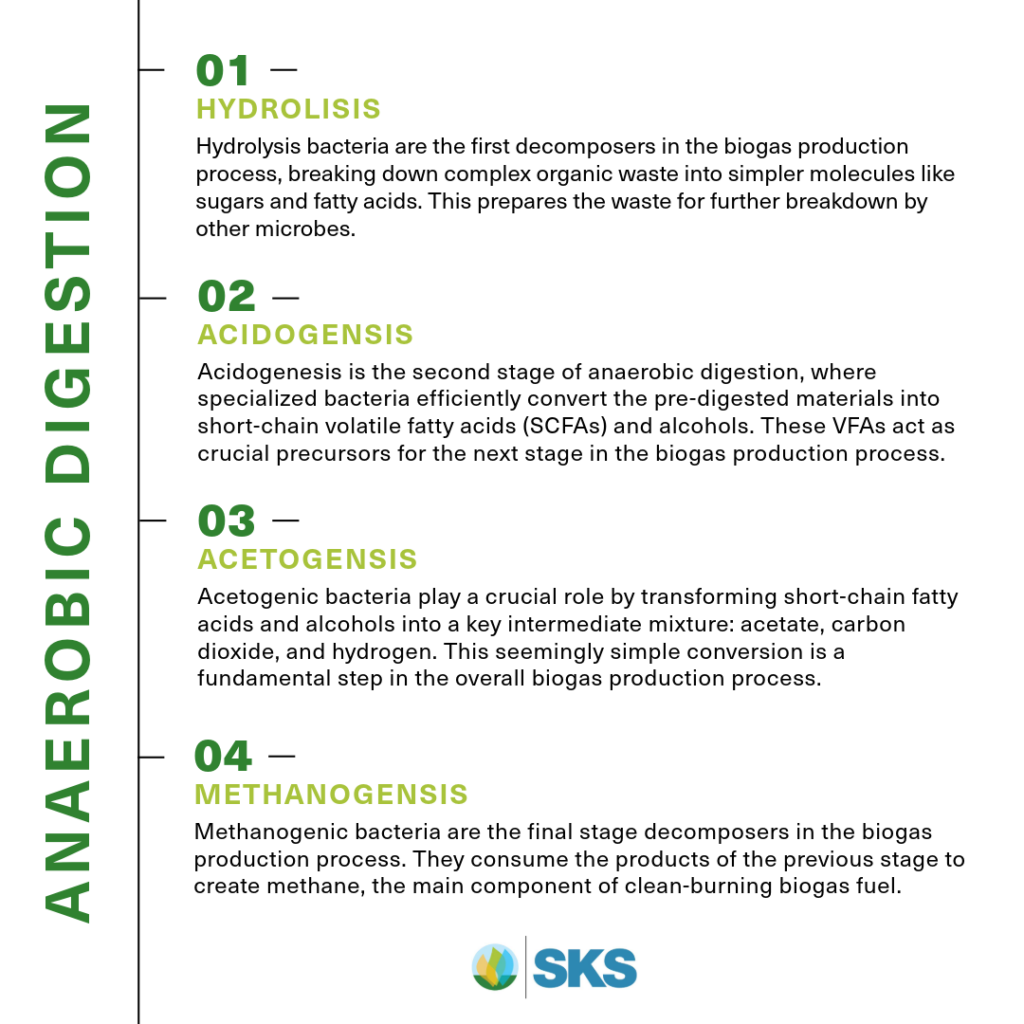Organic waste streams, including food scraps, manure, and wastewater, represent a significant untapped resource for the agricultural and waste management sectors. Biogas production offers a compelling solution to convert this waste into a valuable commodity – clean and renewable biogas fuel.
This article explores the power of anaerobic digestion, a natural process driven by specialized microbial communities.
We’ll delve into the four key stages of anaerobic digestion, highlighting the specific roles of each microbial group in breaking down organic matter and producing biogas. Additionally, we’ll examine the importance of maintaining optimal conditions within the digester to maximize biogas production efficiency. By understanding these factors, organizations can explore the feasibility of implementing biogas technology for waste management and on-site renewable energy generation.
The Four Stages of Anaerobic Digestion

Step One: Hydrolysis
In the first stage of anaerobic digestion, hydrolysis bacteria perform the essential function of degrading complex organic materials. These microscopic decomposers initiate the process by breaking down these insoluble materials into simpler components, such as sugars, fatty acids, and amino acids, effectively preparing the waste for further conversion in subsequent stages.
Step Two: Acidogenesis
Following hydrolysis, acidogenic bacteria take center stage. These highly efficient processors convert the pre-digested materials into short-chain volatile fatty acids (SCFAs) through a series of fermentative reactions. Their role extends beyond simple breakdown; they are responsible for the further degradation of simple sugars, fatty acids, and amino acids into alcohols and VFAs. These VFAs can be likened to the essential building blocks for the subsequent stage’s biochemical transformation.
Step Three: Acetogenesis
The acetogenic bacteria act as the vital intermediary in the process. They convert the short-chain fatty acids (SCFAs) and alcohols produced during acidogenesis into a critical mixture of acetate, carbon dioxide, and hydrogen. While this conversion may appear straightforward, it represents a fundamental step in the biogas production chain.
Step Four: Methanogenesis
The final stage of the process is facilitated by methanogenic bacteria. These highly specialized microorganisms act as the primary consumers of the intermediates produced during acetogenesis. They utilize acetate, carbon dioxide, and hydrogen to generate methane, the principal component of biogas. Methanogens require specific conditions and substrates for optimal performance, highlighting the importance of maintaining a controlled environment within the digester.
Maintaining Optimal Conditions
A healthy biogas operation requires careful monitoring and control of the environment within the digester. This is where process control steps in. Process control involves continuously monitoring and adjusting critical factors like:
- Temperature: Temperature is a critical factor influencing the performance of microbial communities within the digester. Different communities exhibit optimal activity at specific temperature ranges. For most digesters, the ideal range falls between 95-131 degrees Fahrenheit (35-55 degrees Celsius). While fermentation generates some heat naturally (endothermic process), this initial boost may be inadequate. To ensure optimal temperatures from the outset, external heat sources such as hot water heat exchangers or steam injection (exothermic heat sources) can be employed.
- pH Control: The microbial communities responsible for biogas production are sensitive to fluctuations in acidity. Maintaining a stable pH level within the digester, typically between 6.5 and 8.0, is crucial for optimal performance. This ensures a favorable environment for these microorganisms to efficiently break down organic matter and generate biogas.
- Mixing: Regular agitation of the digester contents is crucial for ensuring even distribution of organic material throughout the process. This prevents settling and promotes optimal contact between the microbes and their substrates, ultimately maximizing biogas production efficiency.
Tailored Control Systems for Optimal Biogas Production
The complexity of process control systems varies depending on the chosen digester technology. Here’s an overview of the two main options:
- Advanced Monitoring and Automation: Large-scale digesters often utilize sophisticated computer-based control systems. These systems continuously monitor critical parameters such as temperature, pH, and mixing. They can then automatically adjust heating, mixing, and pumping systems to maintain optimal conditions for efficient biogas production. This high level of automation requires skilled operators with laboratory expertise to ensure proper system function and prevent digester instability, which can lead to a rapid decline in biogas production.
- Remote Monitoring for User-Friendly Operation: Fortunately, smaller digester systems can be operated with simpler control systems. Programmable logic controllers (PLCs) can be used to remotely monitor key parameters with a minimal set of instruments. This user-friendly approach allows for easier operation and maintenance, facilitating a healthy microbial environment for biogas production.
Biogas production offers a compelling solution for transforming organic waste into a valuable resource – clean and renewable biogas fuel. Through the fascinating four-stage process of anaerobic digestion, a dedicated team of microbial communities breaks down organic matter into methane, the key component of biogas. Maintaining optimal conditions within the digester, including temperature, pH, and mixing, is crucial for maximizing biogas production efficiency. Whether utilizing advanced monitoring and automation systems for large-scale operations or opting for user-friendly controls in smaller digesters, this technology presents a sustainable approach to waste management while contributing to a cleaner energy future.
